
The perils of RAS
In a press release issued today, Jonathan Carr, ASF’s Executive Director of Research and Environment, who apparently attended the Tides Canada’s workshop on Recirculating Aquaculture Systems in Vancouver earlier this week, reflected: “The bar has been set very high for other (than RAS) farming operations. Atlantic salmon grown on land are produced without the need for antibiotics or harsh, environmentally harmful chemicals to control disease and parasites."
He must have slept through the presentations by Bjarne Hald Olsen of Billund Aquaculture who described an outbreak of furunculosis at one of Denmark’s largest RAS farms for Atlantic salmon, and Garry Ullstrom’s presentation from the Kuterra land-based RAS project on Vancouver Island which lost 10% of its fish due to a fungus infection. Not to mention Bendik Fyhn Terjesen from NOFIMA in Norway who spoke of the premature killing of all the Atlantic salmon kept in a semi-closed, 20,000m3 floating tank system where the fish were exposed to high concentration of harmful algae before suffering from a severe attack of gill disease.
The RAS picture becomes even more murky when one is to include problems associated with early maturation and often muddy, off-flavour in the finished product. These problems have, however, been acknowledged by the promoters of RAS technology, and a number of research projects aimed at solving these challenges have been carried out and others are underway or being planned. Many of the projects done in North America have been reported by the Conservation Fund’s Freshwater Institute in West Virginia, headed by Steven Summerfelt and funded to a large extent by the Gordon and Betty Moore philanthropic Foundation.
Mr Summerfelt opened the Tides Canada conference by stating that there are now some 12 facilities in the world using RAS technology to produce farmed salmon - five of which have reached the stage of actually selling product. He also said that the amount of warm-water tilapia produced in RAS facilities in the US is approaching the volume of rainbow trout grown in the country - mostly in flow-through raceways in land-based farms. He pointed out that, by using RAS technology, one would only need 1% of the amount of land needed by using pond culture technology, and also less than 1% of the amount of water used by conventional flow-through facilities. Mr Summerfelt pointed out that a fish farm based on RAS technology has to address the issues of premature maturation and off-flavour, but such a facility can achieve a consistent supply of product for the market place if designed right, and if you can keep diseases out.






















































